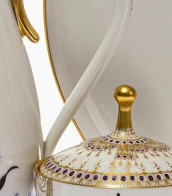Auction
Lot 1124 Deckenleuchter, sogen. Bienenkorb, um 1900, 4-flammig, Messing, verziert, mit reichem Prismenbehang (unvollständig), 1 Blatt der Bekrönung defekt, H. ca. 60 cm, Dm. ca. 40 cm
Kunst und Antiquitäten 

Auktionshaus Satow
Kunst und Antiquitäten
Date: 30.12.2025 11:00 UTC +01:00
Number of lots in the catalog: 1122
Lot 1121 Etagere im Empirestil, spanisches Stilmöbel, blaugrün gefaßt (mit Farbabplatzungen), mit Messing-Applikationen, 3 Glasböden (1x beschädigt), Rückwand verspiegelt, Gebrauchspuren, 188x95x50 cm
Kunst und Antiquitäten 

Auktionshaus Satow
Kunst und Antiquitäten
Date: 30.12.2025 11:00 UTC +01:00
Number of lots in the catalog: 1122
Lot 1118 Tisch mit Marmorplatte, um 1860, Holz farbig gefaßt und vergoldet, grüne Marmorplatte (2x Riß repariert), beschnitzte Tischkante, Säulen mit Floraldekor, 76x147x48 cm
Kunst und Antiquitäten 

Auktionshaus Satow
Kunst und Antiquitäten
Date: 30.12.2025 11:00 UTC +01:00
Number of lots in the catalog: 1122
Lot 1116 Eßgruppe im Barockstil, 20. Jh., Birke, bestehend aus ovalem Ausziehtisch, 74x140x100 cm, 2 Einlegeplatten, 48x100 cm und 8 Stühlen mit gepolstertem Sitz mit braunem Lederbezug, Rückenlehne mit geschweifter Mittelzunge…
Kunst und Antiquitäten 

Auktionshaus Satow
Kunst und Antiquitäten
Date: 30.12.2025 11:00 UTC +01:00
Number of lots in the catalog: 1122
Lot 1114 Barock-Schrank, massiv Eiche, Norddeutschland, dat. 1757, floral beschnitzt, 2-türig, im Sockel 2 Schubkästen, auf Kugelfüßen, mit 4 Einlegeböden, Gebrauchspuren, zerlegbar, 210x193x68 cm
Kunst und Antiquitäten 

Auktionshaus Satow
Kunst und Antiquitäten
Date: 30.12.2025 11:00 UTC +01:00
Number of lots in the catalog: 1122
Lot 1109 Biedermeier-Sekretär, Nußbaum, Front reich floral intarsiert, 2 seitl. ebonisierte Vollsäulen, in der Front 3 Schubkästen, hinter Schreibklappe Innenleben mit 6 Schubladen, 2 fehlen, verspiegeltes Mittelfach, Geheimfach,…
Kunst und Antiquitäten 

Auktionshaus Satow
Kunst und Antiquitäten
Date: 30.12.2025 11:00 UTC +01:00
Number of lots in the catalog: 1122
Lot 1106 Sitzgruppe, 20. Jh., Nußbaum, bestehend aus 6 Stühlen und Klapptisch mit Messingschuhen auf Rollen, Platte mit beidseitig abklappbaren Platten, 70x120/200x105 cm, Stühle mit gepolstertem Sitz und blauem Stoffbezug, Rücke…
Kunst und Antiquitäten 

Auktionshaus Satow
Kunst und Antiquitäten
Date: 30.12.2025 11:00 UTC +01:00
Number of lots in the catalog: 1122
Lot 1105 Säulen-Kommode, Ende 19. Jh., Mahagoni furniert mit allseitigen Blumenintarsien, 3 Schubladen, Deckplatte und Seiten gerissen, Furnierschäden, restaurierungsbed., 104x51x43 cm
Kunst und Antiquitäten 

Auktionshaus Satow
Kunst und Antiquitäten
Date: 30.12.2025 11:00 UTC +01:00
Number of lots in the catalog: 1122



























































